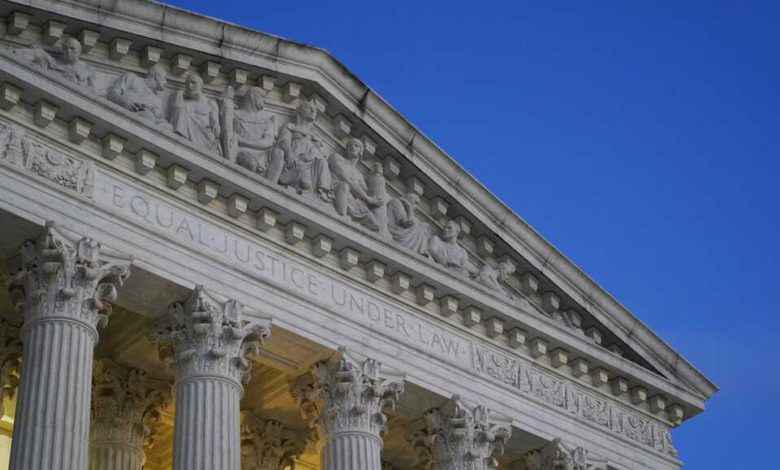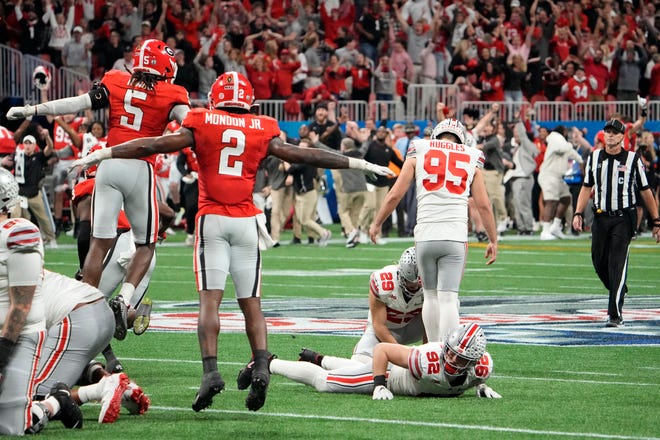

>> AMERICANS GIVE THEIR TAKE ON THEIR IDEAL COMMANDER-IN-CHIEF. YOU ARE WATCHING "MATTER OF FACT," AMERICA’S NUMBER ONE NATIONALLY SYNDICATED PUBLIC AFFAIR SOLEDAD: A POST-ROE AMERICA MEANS MORE THAN JUST LIMITING ACCESS TO ABORTION SERVICES. THE REPEAL OF ROE VERSUS WADE IS ALSO A ROADBLOCK FOR MEDICAL SCHOOLS TRYING TO TRAIN FUTURE OB-GYNS. MED STUDENTS ARE REQUIRED TO LEARN ABORTION-RELATED PROCEDURES IN THEIR RESIDENCY PROGRAMS. BUT THE PROCEDURE IS NOW BANNED OR HEAVILY RESTRICTED IN NEARLY HALF OF THE NATION. LAST MONTH, WE TALKED TO MED STUDENTS IN WISCONSIN WITH VERY DIFFERENT VIEWS ON ABORTION AND THE TRAINING THEY NEED. STUDENTS IN STATES BANNING ABORTION MUST LOOK OUTSIDE THE STATE TO COMPLETE THEIR EDUCATION. OUR CORRESPONDENT DAN LIEBERMAN HEADS TO ILLINOIS. WHERE MEDICAL SCHOOLS ARE SCRAMBLING TO ACCOMMODATE THE INFLUX OF STUDENTS DESPERATE TO ENROLL. >> SO YOU HAVE SIX SPOTS FOR RESIDENTS HERE? >> I THINK WE’RE OVER 1000 APPLICATIONS THIS YEAR. FOR THOSE SIX SPOTS. >> I MEAN, THAT’S JUST STAGGERING. >> I KNOW. >> AT RUSH UNIVERSITY MEDICAL SCHOOL IN CHICAGO, DR. SADIA HAIDER’S OB- GYN RESIDENCY PROGRAM IS FEELING THE PRESSURE FROM OUT-OF-STATE APPLICANTS SEEKING TRAINING REFUGE IN A STATE WHERE ABORTION IS STILL LEGAL. IS IT HARDER THAN EVER TO TURN AN APPLICANT AWAY KNOWING THAT THEY MAY NOT BE ABLE TO GET THIS TRAINING ANYWHERE ELSE? >> IT FEELS TOUGH TO MAKE THOSE DECISIONS. OTHER PROGRAMS REACH OUT TO US AND SAY, YOU KNOW, WE HAVE RESIDENTS THAT NEED TRAINING. CAN YOU TAKE THEM THERE? THERE ARE ONLY A CERTAIN NUMBER WE CAN WORK WITH OR TRAIN. BUT WE DO FEEL VERY COMPELLED TO SUPPORT THE NEXT GENERATION OF PROVIDERS TO GET THIS TRAINING. >> WHEN JUST OVER HALF OF THE COUNTRY HAS TRAINING SPOTS AVAILABLE AND THE OTHER HALF NEEDS THEIR RESIDENTS TO TRAIN IN THOSE SPOTS, YOU’RE NOT GOING TO HAVE ENOUGH AVAILABILITY. >> ACROSS THE STATE LINE IN WISCONSIN, WHERE ABORTION IS NOW EFFECTIVELY BANNED, DR. LAURA JACQUES IS TRYING TO FIGURE OUT OPTIONS FOR HER STUDENTS AT THE UNIVERSITY OF WISCONSIN-MADISON -- WISCONSIN-MADISON. >> IT’S INCREDIBLY COMPLICATED FOR THE SCHOOLS AND THE ADMINISTRATIONS TO FIGURE OUT WHETHER OR NOT IT’S GOING TO BE ALLOWED, WHETHER IT’S GOING TO BE LEGAL FOR THEIR TRAINEES TO GO INTO ANOTHER STATE, FOR THEIR RESIDENTS TO GO INTO ANOTHER STATE. WE’RE GOING TO HAVE TO POUR RESOURCES INTO FIGURING OUT HOW TO CREATE TRAINING PROGRAMS. >> WE KNOW THAT MATERNAL MORTALITY IS HIGHER IN STATES WHERE ABORTIONS ARE BANNED. HOW DO YOU SEE THE ENVIRONMENT POST DOBBS IMPACTING THESE DISPARITIES? >> I ALREADY SEE PATIENTS WHO COME IN FOR OBSTETRIC CARE FROM SOMETIMES AS FAR AS TWO OR TWO AND A HALF HOURS AWAY. AND THAT’S DRIVING IN THE SNOW. WHEN YOU’RE PREGNANT TO COME GET CARE, THERE IS A NUMBER OF RURAL COUNTIES WHO DON’T HAVE OBSTETRIC PROVIDERS ANYWHERE NEARBY, THAT’S NOT GOING TO GET ANY BETTER WITH DOBBS. >> ONE IN FIVE COUNTIES IN WISCONSIN QUALIFIES AS A MATERNITY CARE DESERT, MEANING THEY HAVE LIMITED OR NO ACCESS TO OBSTETRIC SERVICES. DR. JACQUES ARGUES RESTRICTING ABORTION TRAINING THREATENS THE HEALTH OF MOTHERS FACING HIGH RISK PREGNANCIES AND THOSE WHOSE PREGNANCY ENDS IN MISCARRIAGE. >> OUR LAW ALLOWS ONLY FOR ABORTION TO SAVE THE LIFE OF THE PREGNANT PERSON. THEN WE SAT DOWN AND WE SAID, WELL, THIS CONDITION GIVES SOMEBODY A 40% CHANCE OF DYING DURING PREGNANCY. IS THAT NOT ENOUGH BECAUSE IT’S LESS THAN HALF. OR THIS CONDITION THE PERSON HAS A 20% CHANCE OF DYING OF MORTALITY. IS THAT TOO MUCH OR IS THAT TOO LITTLE? AND WE COULDN’T STOMACH THEN SENTENCING 20% OF PEOPLE TO NOT HAVING LIFE SAVING CARE. >> WHEN YOU THINK ABOUT SOLUTIONS, WHAT DO YOU THINK A SOLUTION COULD BE? >> THE SOLUTION AT THE HIGHEST LEVEL IS REALLY TO HAVE A FEDERAL PROTECTION OF ROE. THAT REALLY IS THE ULTIMATE SOLUTION. FOR BOTH THE PUBLIC AND POLICYMAKERS TO BE REALLY AWARE OF THE IMPLICATIONS OF THESE RESTRICTIONS. >> FOR PRO-LIFE DOCTORS, FOR PRO-LIFE RESIDENTS IN STATES WHERE ABORTION IS BANNED, WHO SAY THERE IS OTHER WAYS OR OTHER MEANS TO TO DEAL WITH THESE EMERGENCIES OTHER THAN ABORTION. WHAT DO YOU SAY TO THAT? >> WHAT I SAY IS THAT THERE ARE TIMES WHERE THERE’S A NEED FOR THIS SERVICE OR THIS PROCEDURE TO SAVE A PERSON’S LIFE, POTENTIALLY IN THE SETTINGS OF INFECTION, BLEEDING. AND THEN AND IF YOU DON’T HAVE TRAINED PROVIDERS, THAT CAN BE A REAL PROBLEM.
Related video above: Medical schools scramble to accommodate influx of applicants from states enacting abortion bansThe Supreme Court said Thursday it has not determined who leaked a draft of the court's opinion overturning abortion rights, but that the investigation continues.Eight months after Politico published its explosive leak detailing the draft of Justice Samuel Alito's opinion that overturned Roe v. Wade, the court said its investigative team "has to date been unable to identify a person responsible by a preponderance of the evidence."Never before had an entire opinion made its way to the public before the court was ready to announce it. Chief Justice John Roberts ordered an investigation the next day into what he termed an "egregious breach of trust." Investigators “conducted 126 formal interviews of 97 employees, all of whom denied disclosing the opinion” in sworn statements, the court said in a 23-page document posted on its website.Some employees had to amend their written statements after they “admitted to telling their spouses about the draft opinion or vote count,” the report said.The court said it could not rule out that the opinion was inadvertently disclosed, “for example, by being left in a public space either inside or outside the building."Investigators looked closely at connections between court employees and reporters, and they found nothing to substantiate rampant speculation on social media about the identity of the leaker.The investigation concluded that it “is unlikely that the Court’s information technology (IT) systems were improperly accessed by a person outside the Court,” following an examination of the court’s computers, networks, printers, and available call and text logs.The “risk of both deliberate and accidental disclosures of Court-sensitive information” grew with the coronavirus pandemic and shift to working from home, the report said. More people working from home, ”as well as gaps in the Court’s security policies, created an environment where it was too easy to remove sensitive information from the building and the Court’s IT networks,” the report said.Investigators are continuing to “review and process some electronic data that has been collected and a few other inquiries remain pending,” the report said.Roberts also asked former Homeland Security Secretary Michael Chertoff, himself a onetime federal judge, to assess the investigation. Chertoff, in a statement issued through the court, described it as thorough.Politico published the draft decision on May 2. Less than 24 hours later, Roberts confirmed the draft’s authenticity and said he had directed the court’s marshal, former Army Col. Gail Curley, to lead the investigation.Since then, there had been silence from the court — until Thursday.The court had declined to say anything about the status of the investigation or whether an outside law firm or the FBI has been called in or whether it had taken steps to try to prevent a repeat. Speaking in Colorado in September, Justice Neil Gorsuch said he hoped a report was coming “soon” but he did not say whether it would be made public.Gorsuch joined Roberts in condemning the breach of trust the leak engendered. Justice Clarence Thomas spoke in even starker terms about the leak’s effect on the justices.“When you lose that trust, especially in the institution that I’m in, it changes the institution fundamentally. You begin to look over your shoulder. It’s like kind of an infidelity that you can explain it, but you can’t undo it,” he said while speaking at a conference in Dallas less than two weeks after the leak became public.The leak itself sparked protests and round-the-clock security at justices’ homes. Alito said it made the conservative justices who were thought to be in favor of overturning Roe v. Wade “targets for assassination” that “gave people a rational reason to think they could prevent that from happening by killing one of us.”In early June, a man carrying a gun, a knife and zip ties was arrested near Justice Brett Kavanaugh’s house in Maryland after threatening to kill the justice. The man told police he was upset by the leaked draft.Responding to protests outside the court, officials ringed the building with hard-to-climb fencing, the same barrier that was in place for months following the Jan. 6, 2021, attack on the Capitol.When the final decision was released on June 24, it was remarkably similar to the draft that was leaked. Alito, Thomas, Gorsuch, Kavanaugh and Justice Amy Coney Barrett voted to overturn Roe.Speculation has swirled since the draft’s release about who might be the source. Only the justices, a small number of staff and the justices’ law clerks, young lawyers who spend a year at the court helping the justices with their work, would have had access to the document.Conservatives pointed fingers at the liberal side of the court, speculating that the leaker was someone upset about the outcome. Liberals suggested it could be someone on the conservative side of the court who wanted to ensure a wavering justice didn’t switch sides.It would have taken just one conservative justice to side with Roberts to alter the decision. Instead of overturning Roe entirely, Roberts favored weakening abortion rights.
Related video above: Medical schools scramble to accommodate influx of applicants from states enacting abortion bans
The Supreme Court said Thursday it has not determined who leaked a draft of the court's opinion overturning abortion rights, but that the investigation continues.
Eight months after Politico published its explosive leak detailing the draft of Justice Samuel Alito's opinion that overturned Roe v. Wade, the court said its investigative team "has to date been unable to identify a person responsible by a preponderance of the evidence."
Never before had an entire opinion made its way to the public before the court was ready to announce it.
Chief Justice John Roberts ordered an investigation the next day into what he termed an "egregious breach of trust."
Investigators "conducted 126 formal interviews of 97 employees, all of whom denied disclosing the opinion," the court said.
The investigation concluded that it "is unlikely that the Court's information technology (IT) systems were improperly accessed by a person outside the Court," following an examination of the court's computers, networks, printers, and available call and text logs.
The "risk of both deliberate and accidental disclosures of Court-sensitive information" grew with the coronavirus pandemic and shift to working from home, the report said. More people working from home, "as well as gaps in the Court's security policies, created an environment where it was too easy to remove sensitive information from the building and the Court's IT networks," the report said.
Investigators are continuing to "review and process some electronic data that has been collected and a few other inquiries remain pending," the report said.
Source link








